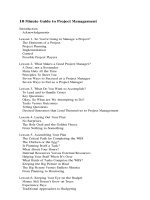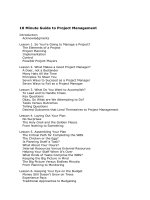10 Minute Guide to Project Management Part 6
Bạn đang xem bản rút gọn của tài liệu. Xem và tải ngay bản đầy đủ của tài liệu tại đây (61.46 KB, 18 trang )
Lesson 13. A Construction Mini-Case
In this lesson, you learn how a thorough initial research phase can pay off handsomely for your
project, that open and easy communication is critical to your project's success, the difference
between getting by and excelling, and that simple solutions often are best.
Helping Construction Site Managers to Be More Effective
Bob works for a large metropolitan construction firm that handles anywhere from 20 to 40 projects
in a given year ranging from new home construction, office buildings, and parking lots, to assorted
public works projects. Each project is headed by a project foreman who has various assistants and
has anywhere from 5 to 25 crew members who perform the heavy labor.
Much like any company in the construction field, the company has had its ups and downs over the
past several years. Regional weather patterns, shrinking municipal budgets, new competition in
the market place, and a host of other factors keep upper management on their toes.
One of the biggest bug-a-boos in the business, as noted by the owner, is due to declining
profitability per job even as the company matures. It was the owner's belief that as a cadre of
highly experienced, well-trained foremen were established, the profit potential on jobs should
improve somewhat.
TIP
A good plan executed by a knowledgeable foreman with sufficient labor should
add up to overall corporate profitability.
Yet, things didn't seem to be working. Even on construction jobs that represented fourth or fifth
jobs for a regular client, where all parties involved were relatively old hands at various processes,
profits were down.
A thorough audit of the company's practices revealed that the critical issue was high turnover
among labor crews. All other factors, such as slight increases in cost of materials, increases in
wages, licenses, permits, bonding, insurance, and the dozens of other issues that go hand in hand
with initiating new constructions were handled relatively well. In fact, compared to other
comparably sized companies in the field, this particular company was above average in many
categories.
Let's Assign It to a Project Manager
Bob was put in charge of a project authorized directly by the owner to determine why the company
was experiencing higher than normal turnover rates among its construction crews, and then, most
importantly, to develop a strategy that would lower turnover rates to that of the industry and
regional standards.
Using the very same software that the company employed to manage individual construction
projects, Bob initiated a project of his own, called "Overturning Turnover," or "OT" for short. Bob
was the solo staff person on the project, no one reported to him; all responsibilities were up to him.
On top of that, the owner had precious little time to spend with Bob, as he was often up to the state
capitol to lobby on certain issues and was the chief marketer for the company as well as the chief
purchasing officer.
So, Bob laid out a plan on his own, based on his experience in the industry. He knew that he
would need to talk to each of the foremen to get their views, several of their assistants, and the
onsite crew chief and vocal leaders.
TIP
Bob chose to eyeball each of the construction sites and talk to all the players
involved face to face, as opposed to using the telephone, even though many of the
foremen would have opened up to him over the phone.
Bob felt certain that the key to successfully completing this project and devising a strategy that
would overturn turnover would be found largely at the sites themselves. In the days that followed,
Bob made the rounds, carved out some time with all of the participants he thought to be important
to speak to, and carefully logged in his notes.
Arm Chair Analysis Versus Onsite Observation
After just his third visit to a construction site, Bob had what he thought was a breakthrough, but
wanted to confirm his findings and continued to maintain his visitation schedule. Bob's major
observation was that the project foremen were largely white, Anglo-Saxon, English-speaking
males (this was no surprise to Bob), whereas over the years, there were increasing numbers of
foreign-born workers who comprised the construction crews.
The company's far-flung empire stretched out over several counties and included projects in major
urban and suburban areas from which the company recruited its labor. In past years, there had
been many Spanish-speaking laborers, many of whom knew sufficient English to get by.
Moreover, among any crew with five or more Spanish-speaking laborers, at least one of them
spoke fluent English. So, the language barrier did not seem to be a problem among Hispanics,
even between the foreman and a non-English–speaking worker, because there was always a
liaison person nearby.
As the entire region began to be inhabited by a more diverse population, construction crews
themselves became more diverse. It was not uncommon for a single crew to have several Spanish-
speaking workers, as well as natives from Korea, Vietnam, Malaysia, India, Afghanistan, several
countries from the Middle East, and various Eastern Europeans including Albanians, Greeks,
Poles, Czechs, and Romanians.
Many workers also came from the Gold Coast, Guiana, war-torn Sierra Leone, and West Africa, as
well as Somalia, Ethiopia, Uganda, and Kenya. From the Western Hemisphere, it was not
uncommon to have Brazilians, who speak Portuguese, workers from any of the Latin or South
American countries, and from French Canada.
In essence, the company's construction crews on many sites represented a virtual United Nations.
When there were several crew members speaking the same tongue and at least one had
reasonable fluency in English, foremen-to-crew relations went reasonably well. But, most often this
wasn't the case. Composition of crew members varied widely from site to site, project to project,
and even from season to season.
Tower of Babel
After delving into the project at length, Bob realized that slightly increasing turnover rates were due
at least in part to the inability of project foremen to communicate directly with individual crew
members.
CAUTION
Even kind or caring project foremen can be less effective at their jobs when
language barriers diminish effective communication.
Bob thought about the history of human kind and the legions of disputes that had occurred
between peoples of different nations who did not speak each other's tongue. If countries
sometimes ended up going to war with one another over misunderstandings, then it made sense
to believe that workers might be departing at higher rates because of their inability to express
themselves adequately, to be heard and understood, to be able to appropriately express
frustration or grievances, and, conversely, to receive appropriate feedback or even praise.
When Bob presented his findings to the owner, at first he was met with a rather cool reception. It
couldn't be that; we have had foreign- speaking crews for years. Bob persevered and explained
that ever more sophisticated project management software and construction, advancing
construction methods, down time and slack time in many projects (other than the owner's task of
adequately replacing the workers and getting new crew members up to speed), was at an all-time
low.
Construction projects were literally being completed at a quicker pace each year, and the timing,
coordination, and precision compared to past operations was a marvel to behold. In other words,
operating at a more efficient pace with little or no slack also meant that there was less overall time
for bonding and conversation in general. Perhaps the modern management efficiencies resulted in
some type of crossing of the threshold when it came to maintaining the human touch.
After a while, the owner bought into Bob's analysis, and, then of course was most interested in the
strategy that Bob had come up with to overturn the turnover. As a result of making his rounds and
collecting the input of many others, and collecting articles in construction industry magazines on
this very same topic, Bob developed a multipart strategy that was inspired, though rather simple
and inexpensive—and the owner liked it!
Bob's plan involved having each of the foremen attend a short training program that he would
design personally. The program would only take an hour and a half and only require one handout
with printing on both sides of the page. The following was Bob's handout.
Motivating the Short-Term Crew Member
Enrique is 19 years old. He came to this country when he was 11, never graduated from high
school, and has only a rudimentary grasp of English. Enrique works on one of your crews. He is a
good worker, is seldom late, and hardly ever complains. You can feel it, though: He is not going to
be at your establishment very long. He will pick up a few dollars and then move on—to where, you
will never know.
Can you increase the job length for workers like Enrique? Indeed, can you motivate someone who,
quite bluntly, toils for long hours for little reward? The answer is a resounding "Yes." It will require
a little effort and ingenuity on your part; still, after all is said and done, Enrique and others in his
situation may still depart on short or no notice. The odds that they will remain with the job longer,
however, will increase if you follow some of the guidelines for motivating these employees.
Check Your Attitude
You need to check your attitude before any motivation program can succeed. As human beings,
we broadcast messages all the time. What are you broadcasting to your crews? That they are
replaceable? That you are not concerned with their needs?
It's easy for the supervisor who has watched dozens of laborers come and go to develop quickly
the view that "It's the nature of the business, why fight it?" It is that attitude that partially
perpetuates the massive turnover in the industry. Resolve that you can take measures to increase
the average longevity of low-paid laborers and your attitude and initiative will make a difference.
An Encouraging Word
How long would it take you to learn some key phrases in Vietnamese, or the language of your low-
paid laborers? Whether they speak Spanish, Korean, or Farsi, it won't take long to master some
short conversational pleasantries. Many bookstores are stocked with dictionaries providing various
language translations. Even easier, sit down with one of your key crew members. On a piece of
paper, jot down the phonetic spelling of phrases such as "How are you?" and "You're doing a good
job."
Unannounced Breaks
Periodically throughout the day, and particularly on challenging days, give your workers
unannounced breaks. Augment these mini-vacations by distributing snacks. The few dollars you
may spend will pay off in terms of greater productivity that day. These breaks will also enhance
longevity among low-paid crew members. It pays to offer little perks.
Rotating Leadership
Rotate leadership among some crews. For instance, on four consecutive days, make sure that
crew members each have one day as "foreman." For some of your workers, this may represent
their first taste of leadership. Rotating leadership is most effective when the crew members are
unfamiliar with each other.
Awards System
Make "contests" short in duration and high on visuals. For example, you could keep a chart on the
wall or other visible location indicating who has had the most consecutive days without being
absent or tardy. Which crew performances have prompted words of praise from customers? Who
has gone above and beyond the call of duty in the last week?
You can easily chart and share these achievements with crew members on duty. People like to
see their names on a chart followed by stars or other performance indicators. The chart could be
language proof, for instance. Everyone recognizes their own name in English, and stars or dollar
signs can indicate the bonuses you'll offer. After posting the charts, set up a simple system of
rewards, which could include cash or more time as a team leader.
Develop Mentors
Look for leaders among your crew members who can serve as mentors to newly hired staff. This
alleviates having to break in each crew member. Those individuals selected as mentors will be
pleased with this special status and will not only assist in achieving smoother operations, but will
help alleviate quick departures among new employees.
Use a Checklist
Here's a checklist to help you determine if you are raising or lowering morale, increasing or
decreasing crew members' length of stay, and serving as a leader, not just as a manager:
●
Do I make sure employees understand how to properly complete a job?
●
Have I clearly indicated what results I expect?
●
Do I offer adequate and ongoing support?
●
Do I cultivate positive relationships?
●
Do I show concern for crew members as individuals?
●
Have I established appropriate recognition and reward systems?
●
Do I take the time to learn and dispense encouraging phrases for enhanced
communication?
Even if you practice all of the above recommendations, you still will not eliminate quick turnover or
enhance crew motivation. Yet, if you can induce the seasonal crew member to stay on an extra
week or encourage crew members to finish a big job on time, then you have made your job a little
easier, and have contributed to the profitability and long-term viability of the company.
After the Handout
Bob covered the entire sheet during this session and then requested each foreman to employ at
least one of the measures with each crew member at least once a week. So, if the foremen had 15
crew members on a project, he was responsible for one of the following measures per crew per
week, or in other words, an average of three such instances a day:
●
Offering an encouraging word in the crew member's native tongue
●
Giving workers unannounced, on-the-spot breaks
●
Rotating leadership among some groups, and so on
Each project manager would then report back to Bob at the end of each week so they could
assess progress. As it turned out, progress was readily visible from the first day on.
TIP
Foreign-born crew members start perking up immediately when people say a few
words or phrases to them in their native language.
At the end of the first week, most foremen reported an increased level of vibrancy, higher morale,
even possibly higher energy level. At the end of several weeks, the foremen were convinced that
the program was sound.
At the end of several months, as they looked at the data on a project-by-project basis, the owner
and Bob could see that the turnover rates were dropping. Workers were staying on longer, and
they didn't need to be replaced, hence project profitability was rising. And both Bob and the owner
felt great about that outcome.
The 30-Second Recap
●
Researching your problem, talking to everyone who might be able to provide insight, and
being observant of your environment and their environment is a strong way to be sure at
the outset that your project is headed in the right direction.
●
Meeting with your sources on their turf can make them more candid and open, and can
help you see aspects of the project you might have overlooked entirely.
●
Even the most qualified, expert professionals are only as good at managing as they are
good at communicating with their teams.
●
Morale and motivation among the troops can come as much from the positive attitude of
management as anything else. Even a menial job can be worthwhile if there is positive
reinforcement for a job well done.









